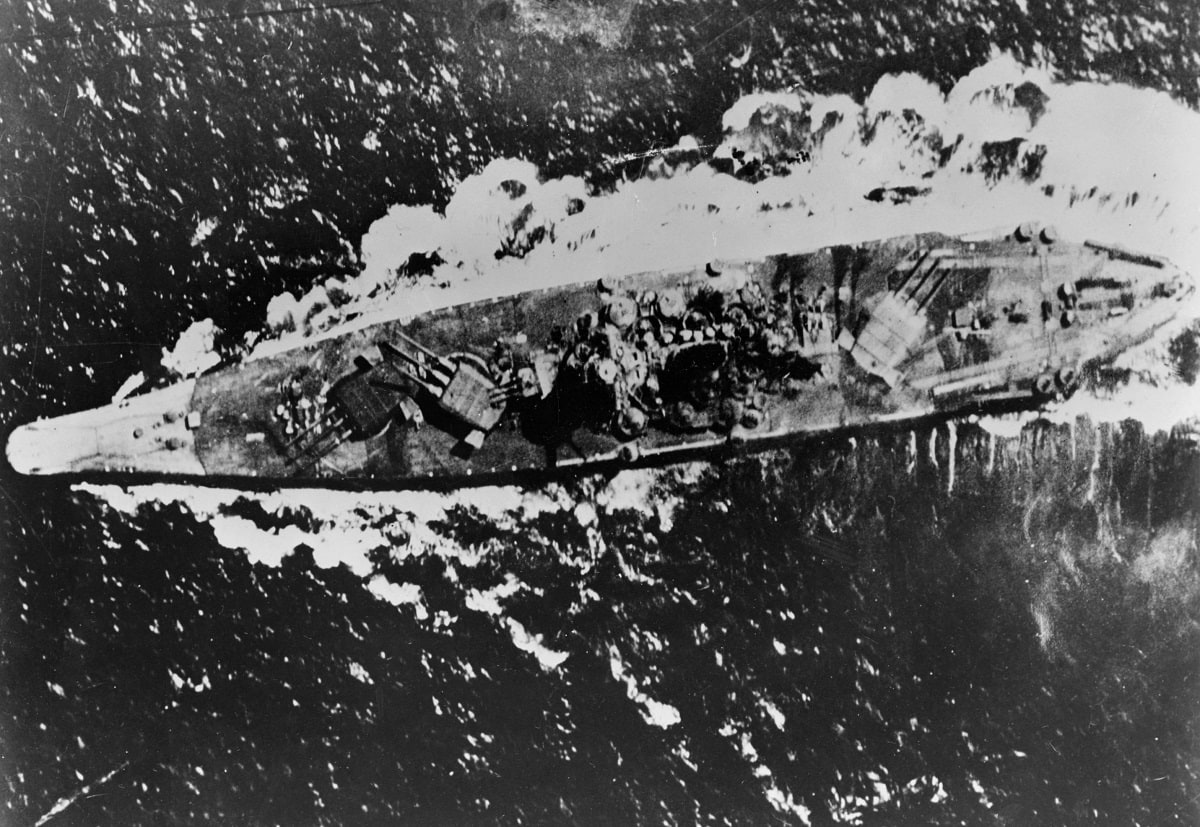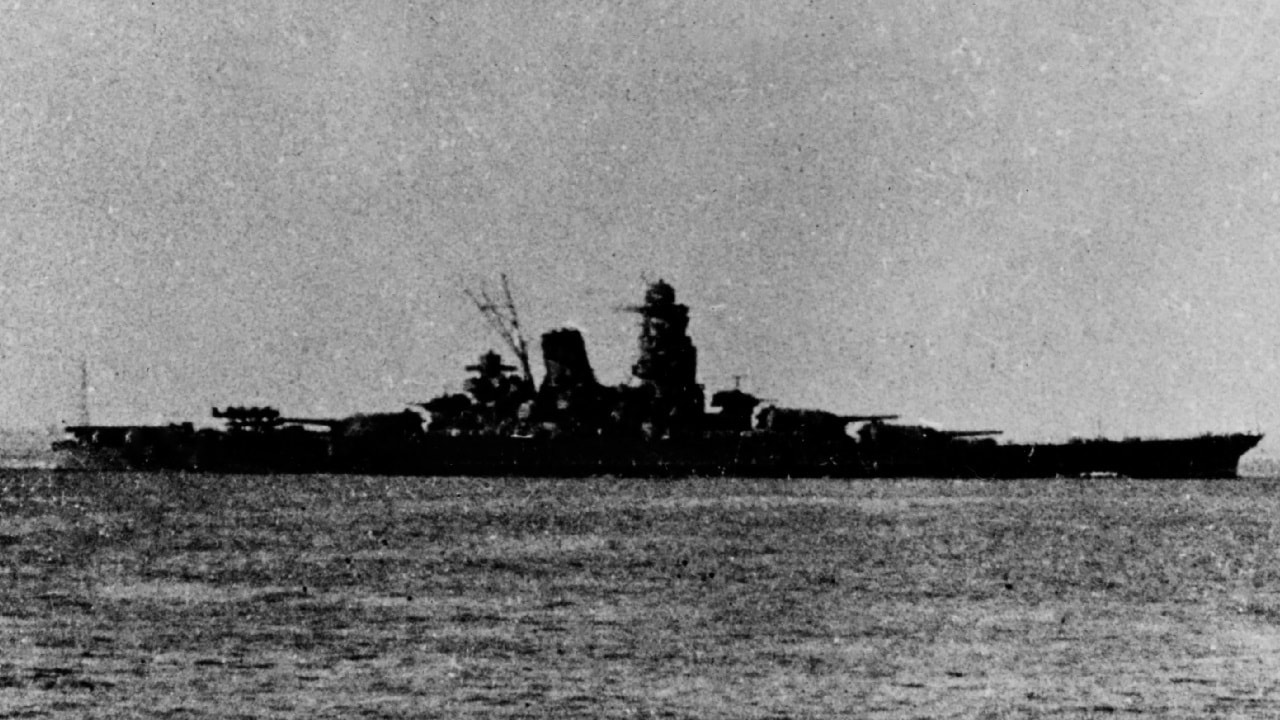Yamato: How the Largest Battleship Ever Was Sent to Its Death

The wreckage of the battleship IJN Yamato was discovered in 1982. She lies 180 miles southwest of Kyushu, at a depth of 1,120 feet.
When considering the role of suicide missions in Imperial Japan’s military machine, kamikaze pilots and banzai charges are what comes to mind. Taking their name from the “Divine Wind” that wiped out an invading Mongol fleet in the 13th century, the kamikaze pilots crashed their planes into U.S. Navy warships. Japanese infantrymen used similar tactics against their U.S. Army and Marine Corps adversaries.
But there is also at least one recorded instance of a suicide mission carried out by the Imperial Japanese Navy (IJN): Operation Ten-Go, which took place on April 7, 1945, and involved the largest battleship in the world, the mighty Yamato.
Yamato Early History and Specifications
So much has been written about the Yamato and her sister ship Musashi — which was sunk in October 1944 during the Battle of Leyte Gulf — that there’s nothing really original to add here. So I’ll just give the basics.
The ship’s keel was laid down on Nov. 4, 1937. The Yamato launched on Aug. 8, 1940, and was commissioned on Dec. 16, 1941. Fully-laden displacement was a massive 72,000 tons, hull length was 862 feet 10 inches, beam width was 127 feet 7 inches, and draft was 36 feet 1 inch. The vessel lumbered across the waves at a maximum speed of 27 knots (31 miles per hour), powered by 12 Kampon boilers and four shafts with four steam turbines.
The Yamato’s primary armament consisted of nine guns — six fore and three aft, all in triple-gun turrets — with an unsurpassed 181-inch bore size. Backing up these ballistic behemoths were six 6.1-inch guns, twelve Type 89 .50 caliber machine guns, a porcupine array of 162 Type 96 25mm anti-aircraft guns, and four Type 93 13mm anti-aircraft guns.
The Killer Planes: TBF Avenger and SB2C Helldiver
The two U.S. Navy warplanes that would send the Yamato to her watery grave and ensure the futility of her suicide mission were the Grumman TBF Avenger torpedo bomber and the Curtiss SB2C Helldiver dive bomber.
The Avenger was the largest single-engine airplane produced during WWII by any nation, with a maximum takeoff weight of 17,893 pounds. A major contributor to that weight was the 1-ton carrying capacity of the weapons bay, which could be filled by either a single 2,000-pound Mark 13 torpedo, or four 500-lb bombs.
The much-hated SB2C, dubbed by its own crews as the “Son of a ***** 2nd Class,” replaced the much-beloved Douglas SBD Dauntless as the Navy’s primary dive bomber. The Helldiver carried a 2,000-lb bomb in its internal bay and an additional 500 pounds-worth of bombs on underwing hardpoints.

Operation Ten-Go: The Objective
The notion driving the ship’s doomed mission was to counter Allied forces landing on Okinawa by dispatching Yamato and her ragtag fleet of escorts on a one-way voyage to the island. Many IJN senior leaders objected to the mission, considering it a waste of resources. Upon arrival, she was to beach herself and be employed as a massive shore battery in a fight to the death.
In what came to be known as the Battle of the South China Sea, the crewmen of U.S. Navy Task Force 58, under the command of Adm. Marc A. “Pete” Mitscher and accompanied by 386 attacking aircraft, were only too happy to oblige their enemy’s inclination to fight to the death. They were not so accommodating, however, about allowing the IJN battlewagon to self-beach. The attack began at 12:37 p.m. and ended with the giant warship erupting in a massive mushroom cloud at 2:23 p.m. after being struck by 11 torpedoes and six bombs. The event took the lives of 3,055 of Yamato’s 3,332-man crew, including fleet commander Vice-Adm. Seiichi Itō. The Yamato certainly put up a gallant fight, including the defiant discharge of her 18-inch main guns, but it was all for naught.

Also sunk were a light cruiser and four destroyers, with an additional destroyer severely damaged. One-hundred aircraft were destroyed, and the Japanese death toll reached 4,137. The Americans lost 10 aircraft, while one aircraft carrier, one battleship, and one destroyer were damaged. In total, 97 combatants were killed and 122 wounded.
Death of the Yamato: an Eyewitness Account
A dramatic eyewitness account of the sinking of Yamato is provided by IJN Capt. Tameichi Hara — who at the time was the skipper of the equally ill-fated IJN light cruiser Yahagi — in the prologue of his bestselling book Japanese Destroyer Captain:

“With startling, unbelievable suddenness I was back on the surface. Dazed, unthinking, and barely able to keep afloat, I was heartened to see that Yamato was still fighting. Scores of American planes swarmed gnatlike over and around her, launching their deadly missiles, but the giant ship still fought on. This encouraging sight helped to rouse me from my stupor. But the sight was short-lived. At 1420 a frightening pillar of fire and white smoke came belching from the battleship, hiding everything. The smoke towered 20,000 feet into the sky. While I watched the smoke gradually lifted, revealing nothing. The great battleship Yamato, pride of the Imperial Navy, had vanished into the sea. The Imperial Navy was finished. I shuddered. Hot tears gushed from my eyes and streamed down my cheeks.”
The Yamato’s Gravesite
The wreckage of the Yamato was discovered in 1982 and fully validated in 1985. She lies 180 miles southwest of Kyushu, at a depth of 1,120 feet.
- Questions and Answers
- Opinion
- Story/Motivational/Inspiring
- Technology
- Art
- Causes
- Crafts
- Dance
- Drinks
- Film/Movie
- Fitness
- Food
- Games
- Gardening
- Health
- Home
- Literature
- Music
- Networking
- Other
- Party
- Religion
- Shopping
- Sports
- Theater
- Wellness
- News
- Culture
- War machines and policy

